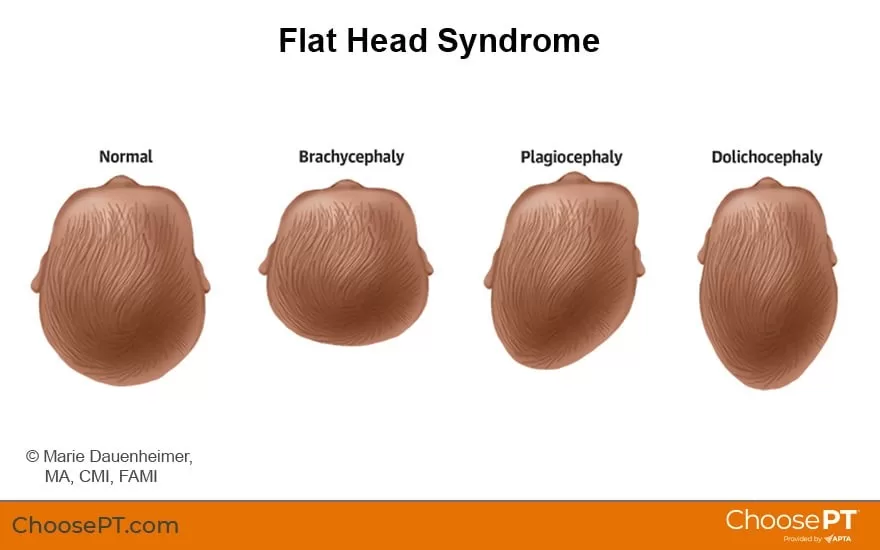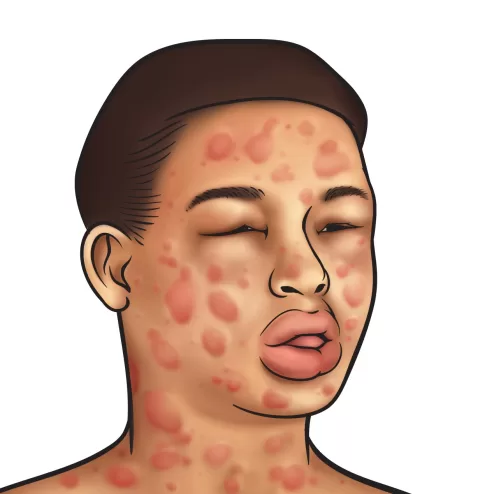Flat Head Syndrome is a prevalent condition that affects many infants, leading to concerns about their developing head shapes. Also known as plagiocephaly, brachycephaly, and scaphocephaly, these forms of flat head syndrome emerge primarily due to continued pressure on a baby’s skull. As parents, understanding these types is crucial, as they can directly influence treatment options and preventative care. With appropriate attention to factors such as sleeping positions and timely intervention strategies, parents can help their babies achieve a more rounded head shape. This informative guide will explore the causes, risk factors, and effective flat head syndrome treatment options available.
The term Flat Head Syndrome encompasses a range of infant head shape deformities, including common types like plagiocephaly, which refers to asymmetrical head shapes; brachycephaly, characterized by a flattened back of the skull; and scaphocephaly, defined by a long and narrow head appearance. These conditions arise from prolonged positional pressure on an infant’s cranium, often exacerbated by the recommended practice of placing babies on their backs to sleep. Alternative descriptions of these conditions, which also highlight their clinical impact, can help caregivers understand the importance of early detection and intervention. In this article, we will thoroughly examine these types, their underlying causes, and the various flat head syndrome treatment options parents can consider for optimal infant head shape development.
Understanding Plagiocephaly: The Most Common Type of Flat Head Syndrome
Plagiocephaly stands out as the most frequently diagnosed form of flat head syndrome, with estimates suggesting that it impacts about 50% of infants in some populations. This condition is characterized by a distinctive asymmetrical head shape, where one side of the skull flattens, leading to a pronounced forehead on the contrasting side. The implications for both aesthetics and potential developmental concerns necessitate early recognition and intervention. Parents should be vigilant to identify any unusual head shapes promptly and consult with pediatric specialists for tailored advice.
The development of plagiocephaly is often linked to consistent positioning during sleep or prolonged time spent in car seats, swings, or carriers. While safe sleep guidelines advocate for babies to sleep on their backs to reduce the risk of SIDS, it’s equally important for caregivers to actively engage in repositioning practices. Incorporating tummy time during wake hours not only helps in preventing plagiocephaly but also aids in overall motor development. Awareness and proactive measures are essential to fostering a healthy head shape for infants.
The Implications of Brachycephaly in Infant Development
Brachycephaly is another prevalent form of flat head syndrome, recognized by its feature of a flattened back of the head along with a wider skull appearance. This condition is commonly seen in infants, particularly those who are placed on their backs for sleep without variability in head positioning. Many parents might be unaware that this sleeping posture can lead to the development of brachycephaly; thus, education on this subject is crucial. Widening awareness about the condition helps families implement changes that can mitigate its effects.
In addition to aesthetic considerations, brachycephaly’s impact on infant development is a significant concern. Research suggests that while many cases resolve naturally as children grow, some may experience developmental delays due to restricted head shape affecting cognitive and motor skills. Parents are encouraged to consult healthcare providers for guidance on best practices to encourage varied positioning and active engagement during playtime—steps that can foster healthier skull development and facilitate optimal growth.
Exploring Scaphocephaly: Causes and Concerns
Scaphocephaly, though less common than its counterparts, presents unique challenges due to its distinctive long and narrow head shape. This type of flat head syndrome is typically associated with craniosynostosis, a condition where the cranial sutures of the skull fuse prematurely. While positional influences can exacerbate the issue, the underlying causes can lead to complex developmental concerns, including possible delays in cognitive and motor functions. Recognizing scaphocephaly early is paramount; seeking intervention or consultation from medical specialists is crucial for appropriate management.
The treatment for scaphocephaly may involve strategies similar to those for plagiocephaly and brachycephaly, such as helmet therapy or physical therapy, depending on severity. However, it’s essential to address the root cause of the condition, especially if craniosynostosis is present. Prompt identification and intervention are essential; as infants grow, their treatment plans may shift to accommodate their developing needs. Parents are advised to engage in open dialogue with healthcare providers to fully understand the implications of scaphocephaly on their child’s development.
Effective Treatment Approaches for Flat Head Syndrome
Treatment options for flat head syndrome vary widely depending on the type and severity of the condition. For cases of mild plagiocephaly or brachycephaly, basic strategies such as repositioning during sleep and increasing tummy time can be effective. Parents should work closely with pediatric healthcare providers to develop a specialized plan that addresses their infant’s specific needs, ensuring proper head shape development. Awareness of the importance of varied positioning and active engagement is key to successful management.
For more pronounced cases of flat head syndrome, especially scaphocephaly or severe plagiocephaly, more intensive interventions like helmet therapy may be warranted. These custom-fitted helmets help reshape the skull by promoting growth in areas that need it while limiting growth in flattened regions. Helmets are most effective when used during early infancy, ideally before six months of age. Regular monitoring and continuation of physical therapy to enhance neck strength are also crucial for overall success and progress in treatment.
Prevention Strategies for Flat Head Syndrome
Preventing flat head syndrome is a multifaceted approach that begins with understanding the infant’s positioning during sleep, play, and transport. From the earliest days, parents should be educated on the importance of providing varied head positions for their baby to avoid prolonged pressure on one area of the skull. This can be accomplished through alternating head positions during sleep, engaging infants in tummy time while awake, and providing plenty of opportunities for them to interact with toys placed at different angles.
Furthermore, parents should be informed about the importance of regular pediatric checkups to monitor head shape and development. Early detection of any abnormalities can lead to timely interventions, which greatly increase the chances of successful correction. Implementing proactive strategies and maintaining constant communication with healthcare professionals can provide families peace of mind, ensuring a healthy developmental trajectory for their infants.
Frequently Asked Questions
What causes Flat Head Syndrome in infants?
Flat Head Syndrome in infants is mainly caused by consistent external pressure on the skull, often due to a specific sleeping position. Conditions like plagiocephaly, brachycephaly, and scaphocephaly often develop when babies lie on their backs for prolonged periods without changing positions. Additional risk factors include torticollis, which limits neck movement, and prematurity, which contributes to softer skulls more susceptible to deformation.
How can I identify plagiocephaly in my baby?
Plagiocephaly, a common type of Flat Head Syndrome, can be identified by the baby’s head appearing parallelogram-shaped due to one side being flattened. This typically results in the forehead on one side protruding while the opposite side is flatter. If you notice any unusual head shape or asymmetry, it’s advisable to consult a healthcare provider for evaluation and potential treatment.
What treatments are available for brachycephaly?
Treatment options for brachycephaly, which is characterized by flattening at the back of the head, include physical therapy to improve neck movement and repositioning strategies during sleep and awake time. In some severe cases, helmet therapy may be recommended to promote proper head shape development by encouraging growth in the flattened areas while restricting excess growth in other areas.
Is scaphocephaly the same as Flat Head Syndrome?
Scaphocephaly is a specific type of Flat Head Syndrome characterized by a long and narrow head shape, often linked to craniosynostosis. While both scaphocephaly and Flat Head Syndrome share common origins in abnormal head shape, scaphocephaly is less common and may require more specialized intervention. Understanding the distinctions can help ensure appropriate management of the condition.
How can I prevent Flat Head Syndrome in my baby?
Preventing Flat Head Syndrome involves implementing safe sleep practices and promoting varied head positions during both sleep and tummy time when the baby is awake. Regularly repositioning your baby’s head while they sleep and ensuring they have supervised tummy time will encourage healthy neck muscle development and reduce pressure on any one part of the skull.
| Type | Description | Common Causes | Treatment Options |
|---|---|---|---|
| Plagiocephaly | Most common type; characterized by a flat spot on one side leading to a flattening that gives a parallelogram shape. | Prolonged sleep in one position; not varying head position. | Physical therapy, helmet therapy, parental education. |
| Brachycephaly | Flattening at the back of the head, resulting in a wider head shape. | Consistent back-sleeping without changing head position. | Physical therapy, parental education. |
| Scaphocephaly | Long and narrow head shape, often linked to craniosynostosis. | Craniosynostosis, positional influences. | Helmet therapy, physical therapy, early intervention. |
Summary
Flat Head Syndrome encompasses common head shape deformities known as plagiocephaly, brachycephaly, and scaphocephaly, which are significant for parents and caregivers to understand. Each type presents unique challenges but can often be addressed with appropriate treatment and preventative measures. Early recognition, effective communication with healthcare professionals, and implementing safe sleep practices are crucial in managing and overcoming these conditions. Through educational efforts and proactive care, families can foster healthy development in infants, paving the way for positive outcomes.
The content provided on this blog (e.g., symptom descriptions, health tips, or general advice) is for informational purposes only and is not a substitute for professional medical advice, diagnosis, or treatment. Always seek the guidance of your physician or other qualified healthcare provider with any questions you may have regarding a medical condition. Never disregard professional medical advice or delay seeking it because of something you have read on this website. If you believe you may have a medical emergency, call your doctor or emergency services immediately. Reliance on any information provided by this blog is solely at your own risk.








